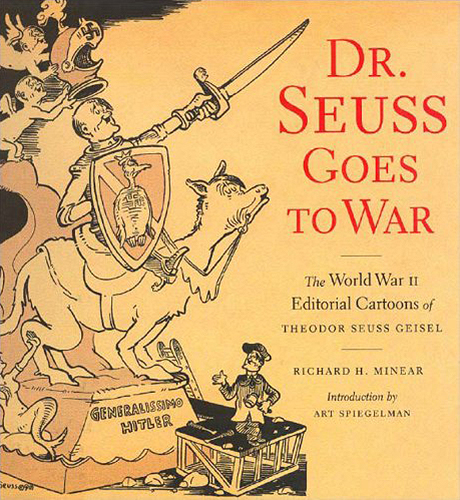The bestselling treasure trove of World War II political cartoons by Dr. Seuss. For decades, readers throughout the world have enjoyed the marvelous stories and illustrations of Theodor Seuss Geisel, better known as Dr. Seuss. But few know the work Geisel did as a political cartoonist during World War II, for the New York daily newspaper PM. In these extraordinarily trenchant cartoons, Geisel presents "a provocative history of wartime politics" (Entertainment Weekly).
Dr. Seuss Goes to War features handsome, large-format reproductions of more than two hundred of Geisel's cartoons, alongside "insightful" (Booklist) commentary by the historian Richard H. Minear that places them in the context of the national climate they reflect. Pulitzer Prize-winner Art Spiegelman's introduction places Seuss firmly in the pantheon of the leading political cartoonists of our time. 200 black-and-white illustrations.Before Yertle, before the Cat in the Hat, before Little Cindy-Lou Who (but after Mulberry Street), Dr. Seuss (Theodor Geisel) made his living as a political cartoonist for New York newspaper PM. Seuss drew over 400 cartoons in just under two years for the paper, reflecting the daily's New Deal liberal slant.
Starting in early 1941, when PM advocated American involvement in World War II, Seuss savaged the fascists with cunning caricatures. He also turned his pen against America's internal enemies--isolationists, hoarders, complainers, anti-Semites, and anti-black racists--and urged Americans to work together to win the war. The cartoons are often funny, peopled with bowler-hatted "everymen" and what author Art Spiegelman calls "Seussian fauna" in his preface. They are also often very disturbing--Seuss draws brutally racist images of the Japanese and even attacks Japanese Americans on numerous occasions. Perhaps most disturbing is the realization that Seuss was just reflecting the wartime zeitgeist.
Dr. Seuss Goes to War marks the first time most of these illustrations have appeared in print since they were first published. Richard H. Minear's introduction and explanatory chapters contextualize the 200 editorial cartoons (some of whose nuances might otherwise be lost on the modern reader). Those who grew up on Seuss will enjoy early glimpses of his later work; history buffs will enjoy this new--if playful and contorted--angle on World War II. --Sunny Delaney



